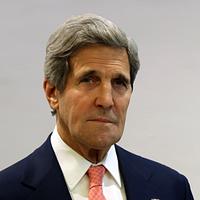Hello, everybody. Let me start by thanking Prime Minister Frederiksen and Minister Kogod [sic] for inviting me to join you as you consider both the challenges and the opportunities that confront Denmark. It’s my privilege to offer a few thoughts about the crisis that I’ve been focused on day in and day out, ever since President Biden was sworn in. The fact is, the climate crisis is not only one of the most complex challenges the world is facing, but it also offers, if we approach it correctly, one of the largest opportunities for the Danish economy and all economies in the days ahead.
Six years ago, the Paris Agreement brought countries together with a goal of limiting the total increases in the Earth’s temperature to “well below” two degrees Celsius and to “pursue efforts towards 1.5.” I don’t know about you, but for me “well below” is not 1.9, it’s not 1.8, and it probably should hardly be 1.7. “Well below” means pretty close to 1.5, so we have a lot of work to do. Under the Agreement, each country is committed to do what it determined it could do collectively in order to put the world on the right path.
However, even if every country fulfilled its initial promises – and many are unfortunately falling short – but even if they did fulfill their Paris promise, the temperature of the planet would still rise by upwards of 2.5 or 3 degrees. Does that mean that Paris faked it? No. It means that Paris – the best we could do was bring 196 countries together, all of whom decided to do something to move forward, sufficient to move the world and send a signal to the marketplace that all countries were going to be open for business in alternative, renewable, sustainable development. And, for the first two years that worked: $3.5 billion was invested in alternative renewable energy. But when President Trump came in that stopped, and unfortunately my country, the United States, was absent for a dangerous period of time.
We are now seeing the consequences that – because we didn’t take on required and significant amounts of reduction – we’re seeing what’s happened at 1.2 degrees of warming since the Industrial Revolution. To contemplate doubling that to 2.5 or 3 is to clearly invite catastrophe.
What’s more, in the years since Paris, the scientific community in 2018 announced that the Agreement’s “well below 2 degrees” isn’t in and of itself enough to stave off climate chaos. We have to do better. A seminal 2018 report made it clear that we really must focus on capping warming at 1.5 degrees Celsius. Much more warming than that, and life on our planet will become increasingly unrecognizable and dangerous.
So yes, the climate crisis is a challenge – to put it mildly. And I think most of you are quite familiar with just how big of a challenge we’re talking about – and how unthinkable the consequences will be if we get it wrong. And next week, we’ll have an even starker reminder when the IPCC releases its next report, summarizing what the latest science tells us about the chaos that could mark our shared future.
We know – we really do know – that we have a narrow window to avoid that future.
Simply put: the world needs to cut emissions by at least 45 percent by 2030 to be on a credible path to net zero by midcentury.
So let me just spend a few moments talking about how we do that.
First, by 2030, we must speed up the deployment of the clean technologies that we already have. According to the International Energy Agency, that means:
- The equivalent of building the world's biggest solar plant every day for the next decade.
- It means ramping up renewable energy from wind and solar by four times to reach 1,000GW installed per year in 2030.
- It means ensuring that, in 2030, 60 percent of new car sales around the world are electric vehicles or hydrogen vehicles.
- All of this will fuel a clean energy investment boom, reaching $4 trillion per year by 2030. That is the task ahead of us.
Second, we also need to develop, demonstrate, and scale up emerging technologies during this decade so that they can play a major role in decarbonizing the global economy by 2050. Between now and 2030, the IEA says that:
- Governments will need to invest $90 billion in technology demonstration projects.
- We’ll need to rapidly scale up green hydrogen and clean fuels that can slash emissions from heavy industry, shipping, and aviation.
- We’ll also need to develop the equivalent of installing the largest carbon capture and storage facility currently in operation – only we’re going to have to do that every nine days through 2030.
- A raft of other technologies – spanning advanced renewables and nuclear, long-duration energy storage, smart grids, and direct air capture – will all need to be commercialized and scaled. That is even more of a challenge.
And third, if we invest heavily in clean energy – and in energy efficiency that curbs rising global demand for energy – then demand for fossil fuels will naturally drop.
The good news is that proof is all around us that we actually can do this. Clean energy technologies are already cheaper – vastly cheaper, frankly, than fossil fuels, because nobody ever calculates the real cost of the fossil fuel for the warming of the ocean, the quality of our air, the impact on people’s individual health and cancer, and so forth. So we have a playbook now to do what we need to do across more emerging clean technologies.
Even better, more and more countries are emboldening their commitments to climate action – and they’re reaping the benefits for their people and their economies.
Denmark is in fact a shining example of that – with one of the most ambitious climate plans of any country, on track now to reduce emissions by 70 percent from 1990 levels by 2030. But others are also stepping up as well. Back in April, President Biden hosted Prime Minister Frederiksen and others for a Leaders Summit on Climate. The U.S. announced a new target of achieving a 50 to 52 percent reduction in emissions from 2005 levels and achieving that by 2030. Canada raised its 2030 target from 30 percent to fully 40 to 45 percent by 2030. It’s now working on its own roadmap for implementation. And Japan also stepped up to pledge a reduction of its emissions by 46 to 50 percent by 2030.
These powerful announcements built on the impressive pledges from the European Union to slash emissions by 55 percent by 2030 and the United Kingdom to cut its emissions by 68 percent in the time – in that same timeframe.
So what does that all add up to? Today, countries representing 55 percent of global GDP have announced that by 2030 they have commitments consistent with the global pace required to achieve a 1.5 degree Centigrade limit on the warming.
We simply cannot keep that 1.5 degrees within reach without every one of the world’s major economies acting – without bringing the remaining 45 percent of the world’s GDP that’s now outside of this goal, bring them inside with real plans now for a net-zero transition by midcentury. This is a global responsibility.
At or before COP26, we need to see all of the major economies put forward – not just ambitious 2030 targets, but clear plans for how they will get there over the next decade.
Commitments must be backed by concrete national action plans, policies, and measures. They also need to be matched by suitable investment – both from the public and private sector – in order to finance that new, low carbon world.
In Denmark, you are demonstrating the kind of commitment that’s needed. And I know you realize better than most how dramatically our world is now changing every day.
A few years ago, I had to opportunity to travel to Greenland to visit the incredible Jakobshavn glacier along with Kristian Jensen, who was then the Danish foreign minister. Scientists pointed out the lines many meters above the water today that mark the glacier’s retreat. You could just see them with your naked eye looking across this fjord. And you could see what has happened negatively in the past 15 years. And the line shows an incredible gap more than it did in the entire previous century. While I was there, I boarded a Danish naval vessel and I traveled through the ice fjord. I saw the massive ice chunks that had just broken off from the glacier to melt inexorably into the sea.
Since the 1990s, the pace of that melting has nearly tripled. Every day, 86 million metric tons of ice makes its way down that fjord into the ocean. And the total flow of that that comes off that glacier in a single year is enough water to meet the needs of New York City for two decades.
That, my friends, is happening just off your coast – but the truth is, more and more people around the world are seeing firsthand the havoc that this crisis can unleash. We can mitigate this disaster. We actually have to. But it’s going to take all of us around the world working together, committed, and dogged in our pursuit, and actually doing more than we are doing today. That is exactly what we’ll have to do when the world comes together for COP26 in Glasgow in little less than a hundred days. We have to do more than we are doing today, and in doing so, we can save the next hundred years. Thank you.

